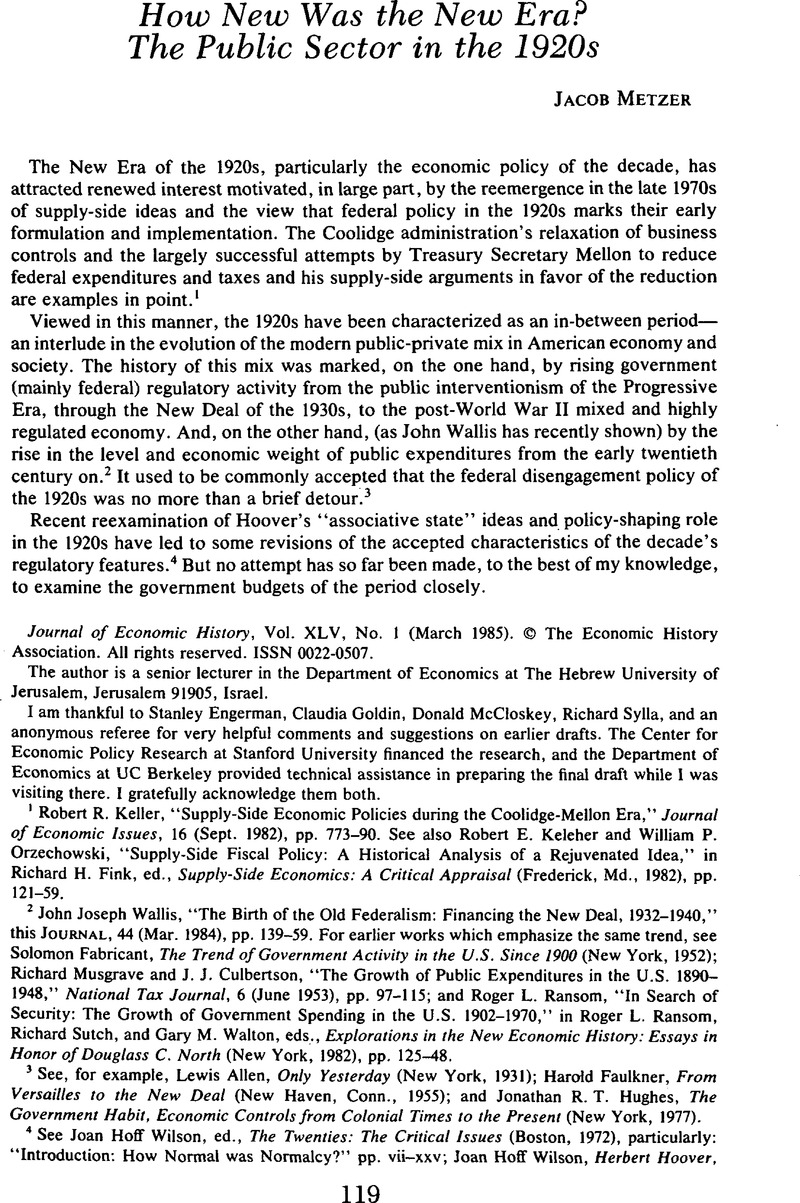Published online by Cambridge University Press: 03 March 2009

1 Keller, Robert R., “Supply-Side Economic Policies during the Coolidge-Mellon Era”, Journal of Economic Issues, 16 (09. 1982), pp. 773–90.CrossRefGoogle Scholar See also Keleher, Robert E. and Orzechowski, William P., “Supply-Side Fiscal Policy: A Historical Analysis of a Rejuvenated Idea” in Fink, Richard H., ed., Supply-Side Economics: A Critical Appraisal (Frederick, Md., 1982), pp. 121–59.Google Scholar
2 Wallis, John Joseph, “The Birth of the Old Federalism: Financing the New Deal, 1932–1940”, this JOURNAL, 44 (03. 1984), pp. 139–59.Google Scholar For earlier works which emphasize the same trend, see Fabricant, Solomon, The Trend of Government Activity in the U.S. Since 1900 (New York, 1952)Google ScholarMusgrave, Richard and Culbertson, J. J., “The Growth of Public Expenditures in the U.S. 1890–1948”, National Tax Journal, 6 (06 1953), pp. 97–115;Google Scholar and Ransom, Roger L., “In Search of Security: The Growth of Government Spending in the U.S. 1902–1970”, in Ransom, Roger L., Sutch, Richard, and Walton, Gary M., eds., Explorations in the New Economic History: Essays in Honor of Douglass C. North (New York, 1982), pp. 125–48.Google Scholar
3 See, for example, Allen, Lewis, Only Yesterday (New York, 1931);Google ScholarFaulkner, Harold, From Versailles to the New Deal (New Haven Conn., 1955);Google Scholar and Hughes, Jonathan R. T., The Government Habit, Economic Controls from Colonial Times to the Present (New York, 1977).Google Scholar
4 See Wilson, Joan Hoff, ed., The Twenties: The Critical Issues (Boston, 1972),Google Scholarparticularly: “Introduction: How Normal was Normalcy?” pp. vii–xxv;Google ScholarWilson, Joan Hoff, Herbert Hoover, Forgotten Progressive (Boston, 1975);Google ScholarHawley, Ellis W., The Great War and the Search for a Modern Order: A History of the American People and Their Institutions, 1917–1933 (New York, 1979);Google ScholarBerkowitz, Edward and McQuaid, Kim, Creating the Welfare State: The Political Economy of the Twentieth Century Reform, (New York, 1980).Google Scholar
5 The sharper decline of expenditures than of receipts in the 1920s reflected the substantial and quite successful efforts of the federal government at reducing the large war-induced national debt.Google Scholar
6 Calculated from the figures underlying the percentage distributions of Table 3 and quoted in the sources of that table.Google Scholar
7 Musgrave, Richard and Culbertson, J. J., “The Growth of Public Expenditures in the U.S. 1890–1948”, National Tax Journal, 6 (06 1953), pp. 97–115.Google Scholar
8 United States Department of Commerce, Bureau of the Census, Historical Statistics of the United States, Colonial Times to 1970 (Washington D.C., 1976), Series F 125–29, p. 232.Google Scholar
9 Musgrave, Richard and Culbertson, J. J., “The Growth of Public Expenditures in the U.S. 1890–1948”, National Tax Journal, 6 (06 1953), Series F 71–97, p. 23.Google Scholar
10 Musgrave, Richard and Culbertson, J. J., “The Growth of Public Expenditures in the U.S. 1890–1948”, National Tax Journal, 6 (06 1953), Series N 1–29, pp. 618–19.Google Scholar
11 See “Historical Statistics on Government Finances and Employment,” in United States Department of Commerce, Bureau of the Census. 1967 Census of Government (Washington D.C., 1967), vol.6, Special Studies, no. 5, tables B 2, 3.Google Scholar
12 Historical Statistics of the United States, Series H 492–507, p. 374.Google Scholar
13 See “Historical Statistics on Governmental Finances and Employment,” tables B 2, 3.Google Scholar
14 Berkowitz, Edward and McQuaid, Kim, Creating the Welfare State, p. 59.Google Scholar
15 The President's [Hoover's, ] Research Committee on Social Trends, Recent Social Trends in the United States (New York, 1933), p. 1228.Google Scholar
16 Kendrick, M. Slade, A Century and a Half of Federal Expenditures (New York, 1955).Google Scholar
17 See Goldin, Claudia, “War,”, in Porter, Glenn, ed., The Encyclopedia of American Economic History (New York, 1980), vol. 3, pp. 935–57.Google Scholar